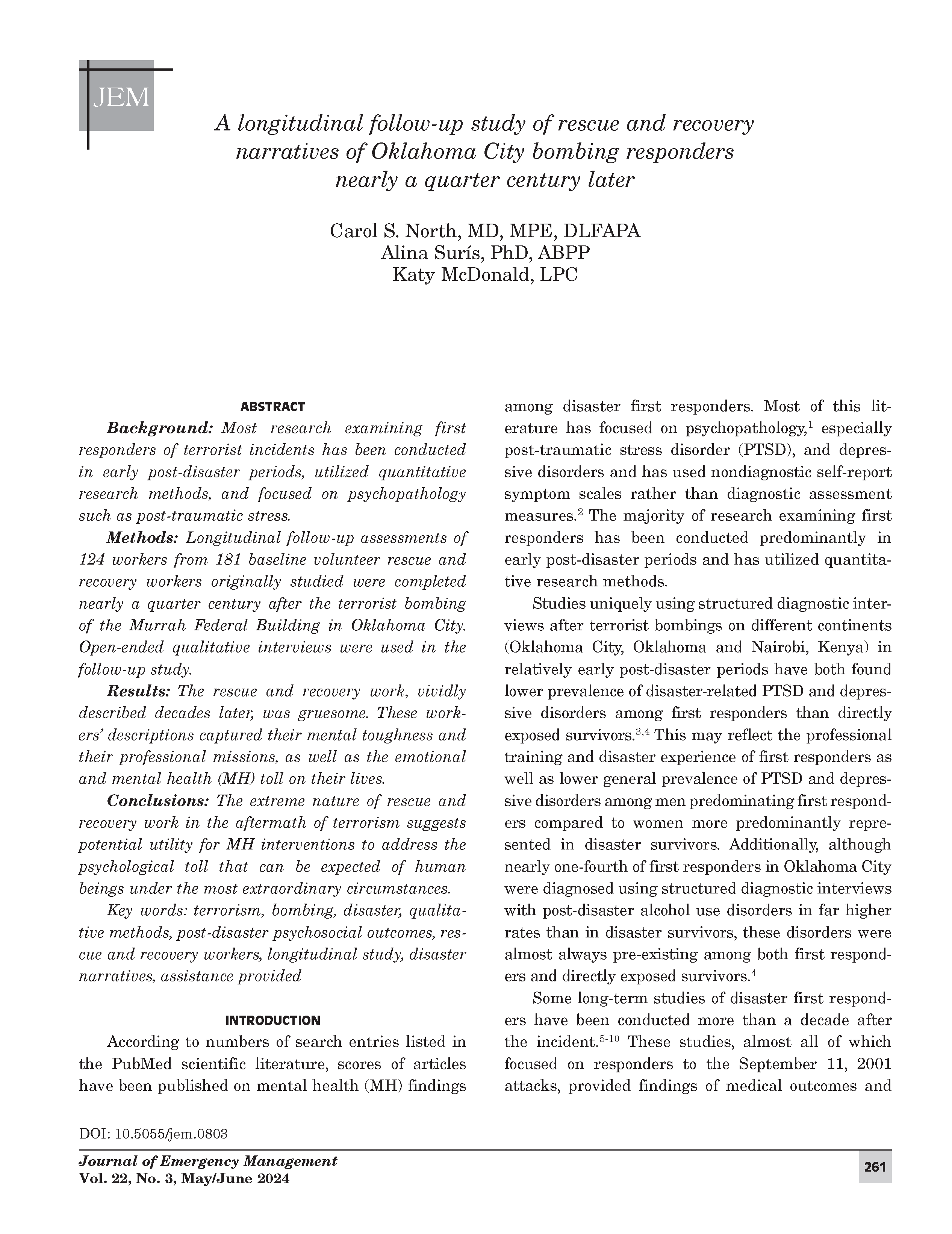A longitudinal follow-up study of rescue and recovery narratives of Oklahoma City bombing responders nearly a quarter century later
DOI:
https://doi.org/10.5055/jem.0803Keywords:
terrorism, bombing, disaster, qualitative methods, post-disaster psychosocial outcomes, rescue and recovery workers, longitudinal study, disaster narratives, assistance providedAbstract
Background: Most research examining first responders of terrorist incidents has been conducted in early post-disaster periods, utilized quantitative research methods, and focused on psychopathology such as post-traumatic stress.
Methods: Longitudinal follow-up assessments of 124 workers from 181 baseline volunteer rescue and recovery workers originally studied were completed nearly a quarter century after the terrorist bombing of the Murrah Federal Building in Oklahoma City. Open-ended qualitative interviews were used in the follow-up study.
Results: The rescue and recovery work, vividly described decades later, was gruesome. These workers’ descriptions captured their mental toughness and their professional missions, as well as the emotional and mental health (MH) toll on their lives.
Conclusions: The extreme nature of rescue and recovery work in the aftermath of terrorism suggests potential utility for MH interventions to address the psychological toll that can be expected of human beings under the most extraordinary circumstances.
References
Garbern SC, Ebbeling LG, Bartels SA: A systematic review of health outcomes among disaster and humanitarian responders. Prehosp Disaster Med. 2016; 31(6): 635-642. DOI: 10.1017/S1049023X16000832. DOI: https://doi.org/10.1017/S1049023X16000832
Wilson LC: A systematic review of probable posttraumatic stress disorder in first responders following man-made mass violence. Psychiatry Res. 2015; 229: 21-26. DOI: 10.1016/j.psychres.2015.06.015. DOI: https://doi.org/10.1016/j.psychres.2015.06.015
Zhang G, Pfefferbaum B, Narayanan P, et al.: Psychiatric disorders after terrorist bombings among rescue workers and bombing survivors in Nairobi and rescue workers in Oklahoma city. Ann Clin Psychiatry. 2016; 28(1): 22-30.
North CS, Tivis L, McMillen JC, et al.: Psychiatric disorders in rescue workers after the Oklahoma city bombing. Am J Psychiatry. 2002; 159(5): 857-859. DOI: https://doi.org/10.1176/appi.ajp.159.5.857
Bromet EJ, Hobbs MJ, Clouston SA, et al.: DSM-IV post-traumatic stress disorder among world trade center responders 11-13 years after the disaster of 11 September 2001 (9/11). Psychol Med. 2016; 46(4): 771-783. DOI: 10.1017/S0033291715002184. DOI: https://doi.org/10.1017/S0033291715002184
Smith E, Holmes L, Larkin B: Health trends among 9/11 responders from 2011-2021: A review of world trade center health program statistics. Prehosp Disaster Med. 2021; 36(5): 621-626. DOI: 10.1017/S1049023X21000881. DOI: https://doi.org/10.1017/S1049023X21000881
Clouston SAP, Guralnik JM, Kotov R, et al.: Functional limitations among responders to the world trade center attacks 14 years after the disaster: Implications of chronic posttraumatic stress disorder. J Traum Stress. 2017; 30(5): 443-452. DOI: 10.1002/jts.22219. DOI: https://doi.org/10.1002/jts.22219
Feder A, Mota N, Salim R, et al.: Risk, coping and PTSD symptom trajectories in world trade center responders. J Psychiatr Res. 2016; 82: 68-79. DOI: 10.1016/j.jpsychires.2016.07.003. DOI: https://doi.org/10.1016/j.jpsychires.2016.07.003
Zvolensky MJ, Kotov R, Schechter CB, et al.: Post-disaster stressful life events and WTC-related posttraumatic stress, depressive symptoms, and overall functioning among responders to the world trade center disaster. J Psychiatr Res. 2015; 61: 97-105. DOI: 10.1016/j.jpsychires.2014.11.010. DOI: https://doi.org/10.1016/j.jpsychires.2014.11.010
Zvolensky MJ, Farris SG, Kotov R, et al.: World trade center disaster and sensitization to subsequent life stress: A longitudinal study of disaster responders. Preventive Med. 2015; 75: 70-74. DOI: 10.1016/j.ypmed.2015.03.017. DOI: https://doi.org/10.1016/j.ypmed.2015.03.017
North CS, McMillen JC, Pfefferbaum B, et al.: Coping, functioning, and adjustment of rescue workers after the Oklahoma city bombing. J Traum Stress. 2002; 15(3): 171-175. DOI: https://doi.org/10.1023/A:1015286909111
Robins LN, Cottler LB, Compton WM, et al.: Diagnostic Interview Schedule for the DSM-IV (DIS-IV). St. Louis, Missouri: Washington University, 2000.
North CS, Pfefferbaum B, Robins LN, et al.: The Disaster Supplement to the Diagnostic Interview Schedule for DSM-IV (DIS-IV/DS). St. Louis, Missouri: Washington University, 2001.
Cohen JA: A coefficient of agreement for nominal scales. Educ Psychol Meas. 1960; 20: 37-46. DOI: https://doi.org/10.1177/001316446002000104
McHugh ML: Interrater reliability: The kappa statistic. Biochem Med. 2012; 22(3): 276-282. DOI: https://doi.org/10.11613/BM.2012.031
Fleiss J: Statistics for Rates of Proportions. 2nd ed. Hoboken, NJ: John Wiley & Sons, 1981.
North CS, McDonald K, Suris A, et al.: A longitudinal study of Oklahoma City bombing rescue and recovery responders providing qualitative introspections of their experience nearly a quarter century later. J Emerg Manage. 2023; 21(1): 23-26. DOI: 10.5055/jem.0740. DOI: https://doi.org/10.5055/jem.0740

Published
How to Cite
Issue
Section
License
Copyright 2007-2025, Weston Medical Publishing, LLC and Journal of Emergency Management. All Rights Reserved.
Leave Nobody Behind: Emergency Management in a More Inclusive Way is a trademark of Journal of Emergency Management





